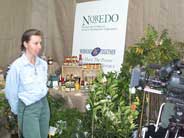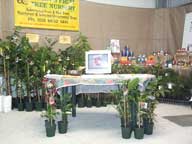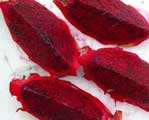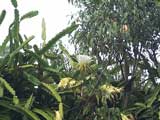July Newsletter
A Gardener's Journal
 During the month of June, the Nursery had a stand at the Primex Farmer's Expo. A highlight of the show was to meet so many of our newsletter recipients and customers. It is amazing how many ideas, snippets and valuable information you can learn from fellow fruit tree enthusiasts. I'd like to share with you an excellent idea given to me by one of our enthusiastic fellow gardeners. This lady described a magnificent garden and explained that the people who bought her home were just as enthusiastic as she was. Imagine their delight when she handed them a 'gardener's journal' with the keys. The book had every plant in the garden included, where it was purchased and relevant information including flowering and pruning times. The pages were alive with notes of additions, successes, failures and details of experimentations.
During the month of June, the Nursery had a stand at the Primex Farmer's Expo. A highlight of the show was to meet so many of our newsletter recipients and customers. It is amazing how many ideas, snippets and valuable information you can learn from fellow fruit tree enthusiasts. I'd like to share with you an excellent idea given to me by one of our enthusiastic fellow gardeners. This lady described a magnificent garden and explained that the people who bought her home were just as enthusiastic as she was. Imagine their delight when she handed them a 'gardener's journal' with the keys. The book had every plant in the garden included, where it was purchased and relevant information including flowering and pruning times. The pages were alive with notes of additions, successes, failures and details of experimentations.
 The idea isn't new and it isn't difficult but so few of us actually do it. We often have customers come back to us and tell us they have no way of identifying the fruit trees in their orchard. Often they have purchased two compatible plants to have one die years later with no means of identifying the remaining one. It is easy for us to identify a genus and species but often not as simple to identify a specific variety. It is now our policy to advise gardener's to keep a diary. It helps us to help you.
The idea isn't new and it isn't difficult but so few of us actually do it. We often have customers come back to us and tell us they have no way of identifying the fruit trees in their orchard. Often they have purchased two compatible plants to have one die years later with no means of identifying the remaining one. It is easy for us to identify a genus and species but often not as simple to identify a specific variety. It is now our policy to advise gardener's to keep a diary. It helps us to help you.
Just imagine how useful a journal such as this could be to us. It could include soil pH tests, unseasonal winter temperatures, annual rainfall measurements and much much more. At the very least a journal such as this would be a touching memory to pass on to our children. The years of experience and knowing guidance would be invaluable.
Greg
 The Pitaya or more commonly known as the dragon fruit is a stunningly beautiful fruit with an intense colour and shape, magnificent flowers and a delicious taste. Once only seen in the finest restaurants it is fast becoming common-place throughout Australia as a magnificent garnish and a delicious fresh fruit.
The Pitaya or more commonly known as the dragon fruit is a stunningly beautiful fruit with an intense colour and shape, magnificent flowers and a delicious taste. Once only seen in the finest restaurants it is fast becoming common-place throughout Australia as a magnificent garnish and a delicious fresh fruit.
To eat the fruit serve chilled and cut in half. The flesh and seeds are scooped out with a spoon, much like a kiwi fruit. The Pitaya is grown from cutting as seedling plants require a much longer time to fruit. Fruit from cuttings should appear from around 3 years. The Pitaya is a climbing cactus that attaches itself to vertical surfaces like house walls and tree trunks. The height of the plant is dependent on its support but it could easily reach 6 metres.
Flowering and pollination
 The pitaya flowers only one night and closes early morning the next day. Pollination takes place at night by bats or insects or early morning by bees. It is documented that pollen must be transferred from a different species of pitaya however from our observations the plants are setting ample fruit planted in isolation. Like many plant groups it is recommended to plant two or more species to maximise the fruit yield.
The pitaya flowers only one night and closes early morning the next day. Pollination takes place at night by bats or insects or early morning by bees. It is documented that pollen must be transferred from a different species of pitaya however from our observations the plants are setting ample fruit planted in isolation. Like many plant groups it is recommended to plant two or more species to maximise the fruit yield.
Varieties
There are 15 types of pitaya around the world but three main varieties in Australia. They are the Hylocereus undatus (red skin, white flesh) H. polyrhizus (red skin, red flesh) and Selenicereus megalanthus (yellow skin, white flesh).
Hylocereus undatus (Haworth) Britt & Rose, is a climbing cactus thought to be from the tropical rainforests of Central and northern South America. It has already received world-wide recognition as an ornamental plant for the large, scented,night-blooming flowers. Its fame is now spreading throughout the world for its fruit, especially in Israel, Vietnam, and Australia. It produces fruit of 1 kilo or more and has a light melon-like taste. The colour of the skin is a beautiful bright red, with translucent white flesh and tiny black seeds. The species is easily recognisable by the triangular cross-section of its stem and minimal spines. This species pollinates very well with H polyrhizus.
The H polyrhizus has a smaller fruit up to 1kilo with red skin and dark-red flesh and small black seeds. The stems of this species have more spines.
The Selenicereus megalanthus has yellow skin and clear to white flesh containing edible black seeds. It has smaller fruit and higher levels of sugar.
The plants are able to tolerate drought, heat, poor soil, and cold. The modification of the stem for water storage, the reduction or absence of leaves, the waxy surfaces, and night-time opening of flowers enable the plants to tolerate harsh conditions. Pitayas are described as xerophyte and succulent plants. Their ability to survive dry, hot conditions, applies to the above-ground plant. The roots are found in the top 15-30 centimetres of soil, are non-succulent and require small amounts of water and cooler temperatures. Be sure that soil does not dry out completely. Cacti will not tolerate saline or water-logged conditions, nor will they grow in an absence of plant life.
We have found that the plants perform well when grown using a host tree as a support. A dead tree with rich compost added at the base is ideal as the plant will derive nutrients from the decaying matter. The branches are encouraged to hang down to promote flowering and fruitset. The adventitious roots that cling to the tree for support do not feed from the host plant. The aerial roots collect water and nutrients from their surroundings, enabling the plant to survive if the base is severed. Water and fertiliser requirements may be lower when compared to other tropical fruit species. A high nitrogen fertiler can be used during vegetative growth but this is reduced during the flowering stages.
Whilst having a good tolerance of harsh conditions the pitaya are still prone to pest infestations such as borers, mites and scale insects.
Back yard frost protection
It was very silent but not unexpected and it certainly left a mark. Brown, dead scorch marks. It was our first frost and it scorched the leaves of many of the young trees we had planted in the entrance to the nursery. This first frost reminded me how important it is to protect fruiting plants against severe cold spells. In the nursery we use sprinklers that are automatically turned on when the gauge reaches a specified temperature. Our warmer climate loving plants are moved into giant polyhouses for the winter and grow on quite oblivious to what is happening outside. Great for us, but not feasible for the home orchardist. Here are some tips to help you through the big freeze.
Encourage tougher plants
As gardener's we know how important it is to grow hardy plants. The healthier and hardier the plant the less susceptible it is to pests and disease. The same rule applies to the plants tolerance of cold temperatures. To toughen plant tissues in late Autumn don't nitrogen fertiliser after Spring when the weather has warmed and new growth begins to appear. Fertilisers high in potassium promotes healthy growth and thick cell walls. Another garden saviour is Seaweed spray. We advise that our customers water new plants in with seaweed fertiliser as it lessens the stress of replanting but it also is a great toughener of plant walls. Keep plants well watered when there is a danger of frosts.
Anti-transpirant sprays
There are also anti-transpirant sprays on the market. These are applied as a foliar spray and add an extra coat of protection against frost and freeze, sudden climatic changes, transplant shock, drought, heat and wind. Many of the products are non-toxic and biodegradable and very easy to apply. Try your local produce store or garden centre for more information.
Having prepared your trees, don't forget to protect the trunk and major branches. This is vitally important for young trees that have only been in the ground for a year or two. The trunk, especially near the graft union, can be protected by covering it with one of the special products made for this purpose. One type of tree wrap comes in a roll and is made of treated paper; another is a spiral ribbon of white plastic. Feel free to improvise, I've seen gradwrap rolls covered with Alfoil and cut lengthwise to easily wrap around the base of the plant.
The Earth's Heat
I know that we are always promoting Mulch Mulch Mulch. However where there is danger of frost it is better to remove the frost from around the base of the tree. Remove both mulch and weeds so that you maximise the heat transfer from the earth to the air. You'll have noticed that plants placed under the leaf canopy of a large tree or a building overhang escape serious frost damage. This is because these covers contain the earth's heat.
Build a protective cover
A wooden framework with shadecloth or heavy-duty hessian can be used to protect plants. (Also protects against wallabies and rabbits). The idea being to trap the heat that is radiating from the ground. I'm yet to see it in action but apparently there is now a garden product that is a light material that can protect against from but it is light enough so not to damage branches when used as a cover. Beware of using plastic as where the plastic touches the leaves, each point of contact will freeze.
Citrus trees
Young citrus trees that have been in the ground less than 12 months are vulnerable, and should be protected if very low temperatures are expected. Older trees might sustain surface damage but will make a full recovery. Limes and lemons are the most tender.
And remember, Frost sure is preferable to Freeze and fortunately not too many of us have to deal with that in Australia. Most of us enjoy abundant water, fertile soil, year round gardening and enough winter chill to enjoy growing a range of deciduous fruit trees.
Happy Winter Gardening.
Citrus news
Australians are leaders when it comes to growing backyard citrus and no doubt there will be a surge of interest in early Spring. July is a good time to stock up on Citrus as the popular lines quickly become depleted. Below are some of our recommendations that look exceptional at the moment and ready to push a fresh spring flush in late July/early August.
Navel Oranges
 The most commonly requested orange is the Washington Navel. They are tried and proven varieties that have met the strict criteria of Auscitrus.
The most commonly requested orange is the Washington Navel. They are tried and proven varieties that have met the strict criteria of Auscitrus.
Newhall and Navelina make up over 50% of Spains planting. Regular and good cropper in subtropical areas. Very early season. Good fruit size (slightly smaller than Washington Navel), excellent flavour with deep orange-reddish rind. Fruit tends to be elongated. Newhall and Navelina are not differentiated when marketed. Newhall is more rounded than Navelina and is not quite as fine in skin texture. Tree slightly less vigorous than Washington.
Navelina A Spanish variety. Navelina produces fruit of excellent quality and brilliant colour, very early in the season. Besides its earliness it has good fruit size and naturally develops an outstanding deep red orange skin which is very attractive. The skin colour develops early in the season and the palatability of the high juice content is excellent. The navelina matures three to five weeks before the Washington navel.
Navelate is a spontaneous mutation of Washington Navel that was found in Spain in 1948. The tree is vigorous and has a good development. The fruit is medium to large in size, slightly smaller than that of Washington Navel, and of excellent quality. It is seedless. In ideal conditions fruit can remain for several months.
Mandarin
Emporer is a mid season, virtually thornless mandarin variety with a bright orange coloured skin on a flat fruit. Rated closely with Imperial and Ellendale in taste it is a preferred variety due to its puffy skin that is easy to peel. The large vigorous tree bears prolifically and performs very well in coastal areas. Matures around 6 weeks after Imperial during May. The fruit needs to be clipped rather than clipped from the tree to lengthen storage time. Adopted as Australia's own the 'Emperor' appears to have been selected from a batch of chance seedlings grown on from stocks originally imported from China.
Testimonials
As always we love to hear from you. Thank you for the testimonials we continue to receive, they are very much appreciated. Our business continues to improve and grow due to the valued feedback of our customers. Greg





